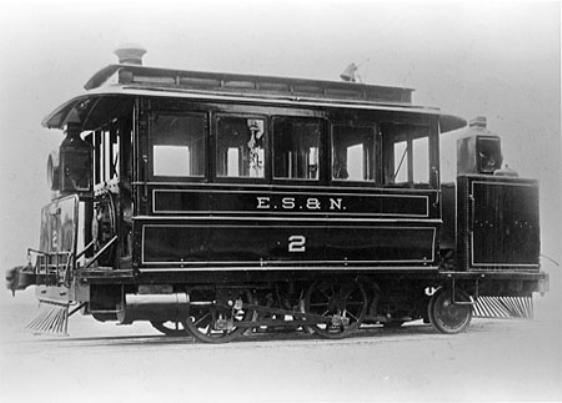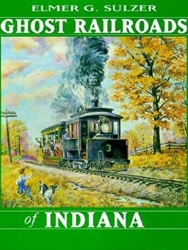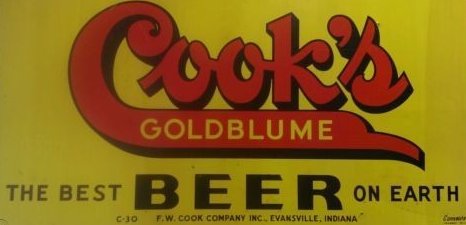"The story of interurban railroads is a fascinating tale and captures the interest of many people. These railroads linked towns and cities, making it easier for people and items to be transported. Interurban railroads had a big impact on society, helping the economy grow and allowing for more movement of people and resources. The charm of these railways is in how they brought faraway communities nearer, building connections and opening up chances for progress. The history of interurban railroads continues to be told, showing us how innovation and connections can change the world." The Evansville Suburban & Newburgh Railroad
The Evansville Suburban & Newburgh Railroad
The ES&N was incorporated on Dec. 15, 1887, with an authorized capital of $50,000. Prime movers in the project were Capt. Lee Howell a division freight agent for the L&N railroad, and William J. Wood, local council for the same line. Intentions were to provide access to coal mines in the vicinity of Newburgh, and to provide a short commuter service for Newburgh, then a town of 1,500.
Pigeon Township, Vanderburgh County voted a $60,000 subsidy for the 10.98 mile line between Evansville and Newburgh with the provision that the ES&N would build a railroad yard and shops, employing at one time no less than 200 men, and that the yard and shops would be put into operation in less than 2 years after the subsidy was voted. This proviso was the principal reason the L&NRR located its shops in south-west Evansville at a point appropriately named Howell. Of the $60,000, $30,000 was transferred to the L&N for this purpose. In return, the L&N took care of repair work for the ES&N for a number of years. Service was introduced to Newburgh on Aug 1, 1889, and by November 1, the line was extended east to a coal mine just beyond the town's limits.
A passenger service of 5 trips a day and freight service were scheduled and 3
Baldwin dummy locomotives were supplied for the passenger and freight runs. To
accommodate the passengers, 12 double truck passenger trailers, 8 open and 4
closed, were secured. Trucks were built by Mesker Steel Company, bodies by the
Hercules Buggy Company. Original freight rolling stock included 20 wooden coal
cars, a flat car, and a caboose.
Fun and gaiety were cheap in those far
away days. At least they were along the 11 mile Evansville Suburban &
Newburgh Railway. There were pleasures to suit the tastes of the most fastidious
as well as the most conservative. At a point just east of the asylum (Woodmere),
Captain John Gilbert had set up an amusement park at which "no ardent spirits
will be sold". The place was described by the promotion minded Captain as an
ideal place for picnics by such organizations as Sunday school groups, who, however, "would have to maintain proper decorum". Evidently, in those days even
some church groups were apt to get out of hand occasionally. In contrast was
Barnett's Grove a few miles down the line. This beautiful spot had been
purchased by F.W. Cook of brewery fame, and had been developed into a rendezvous
for those pleasure bound. Cook was a prominent stock holder in the ES&N and
doubtless located the venture to bring further business to the railway At the
end of the line in Newburgh was the most famed spot of all, namely Kuebler's
Garden, located a few blocks north of the ES&N depot.
For years the
line was prosperous and steady business was putting a strain on the railroad's
capacity, steam service soon became insufficient. To overcome these strains it
was decided to electrify the railroad, and on May 4, 1905, electric interurbans
replaced the steam dummy trains. The entire line was rebuilt and heavier rail
was laid, new oak ties were provided and thresholds and crossings were
reconstructed
For some time officials of the ES&N had been eyeing the rapidly expanding coal mining developments in the vicinity of Boonville. In spite of territory already served by the Southern Railway, a go-ahead was given the project. It was decided to make a junction with the existing Newburgh line at a point in Stockwell woods (now Wesselman Park), and route the track through Stephenson and Chandler to Boonville. Work was started in 1905 and completed on July 3rd, 1906. A maximum grade of .1% was maintained on the Boonville segment, a creditable engineering feat in any mans language.
A liberal schedule was set up with one hour departures from both ends of the line between the hours of 6am and 8pm, plus an additional late night owl car. The first car leaving Boonville in the morning carried about 100 miners to their workings near chandler. On the Newburgh line cars were operated on a frequency of one hour and 20 minutes. Three of the five passenger cars were required to maintain these schedules. The single express car #200 was used on the Boonville line and made two round trips daily. For a while after electrification, steam power assigned to freight service was confined to the dummy locomotives. It was not until 1910 that the ES&N purchased its first non-dummy engine #5.
During the 1920's highway conditions had progressed to a point where bus service was becoming practical. As highways to Boonville and Newburgh were built, the interurban service went into decline. The end of service was precipitated by a fire that burned up the sub-station on the Boonville line. Although temporary help was secured by the loan of a flat car mounted rotary converter supplied by the Evansville & Ohio Valley Railway, it was decided to abandon electric operation. Service to Boonville ended on Aug 4, 1930 and to Newburgh on Dec 15 of the same year. Cars were scrapped and electrical lines were removed.
In the same year, the last of the coal mines on the Newburgh line
ceased operation. Permission was granted July 18, 1941, effective 30 days later.
Similarly, the once flourishing coal business on the Boonville route diminished,
and on January 19, 1947, the mine from which the railroad has been deriving 98%
of it's revenues from was discontinued. In spite of numerous protests from local
residents, the Interstate Commerce Commission granted the ES&N's request to
abandon the Boonville line on May 4, 1948, effective 40 days later. Track and
materials were sold to the Hyman Michels Company, and the line was scrapped.
What remains of the railroad today ? The Boonville trail and Newburgh trail (which
still contains remnants of railroad ties), can still be seen in the Wesselman
Park Nature Preserve.
Copyright© info used by permission from Ghost Railroads of Indiana: Indiana University Press,Elmer G. Sulzer in an editorial/ education manner only,and to the benefit of their owners, with no intention of infringement of their Trademark™ and/or Copyright©. Readers are aware that this information is not to be freely copied








